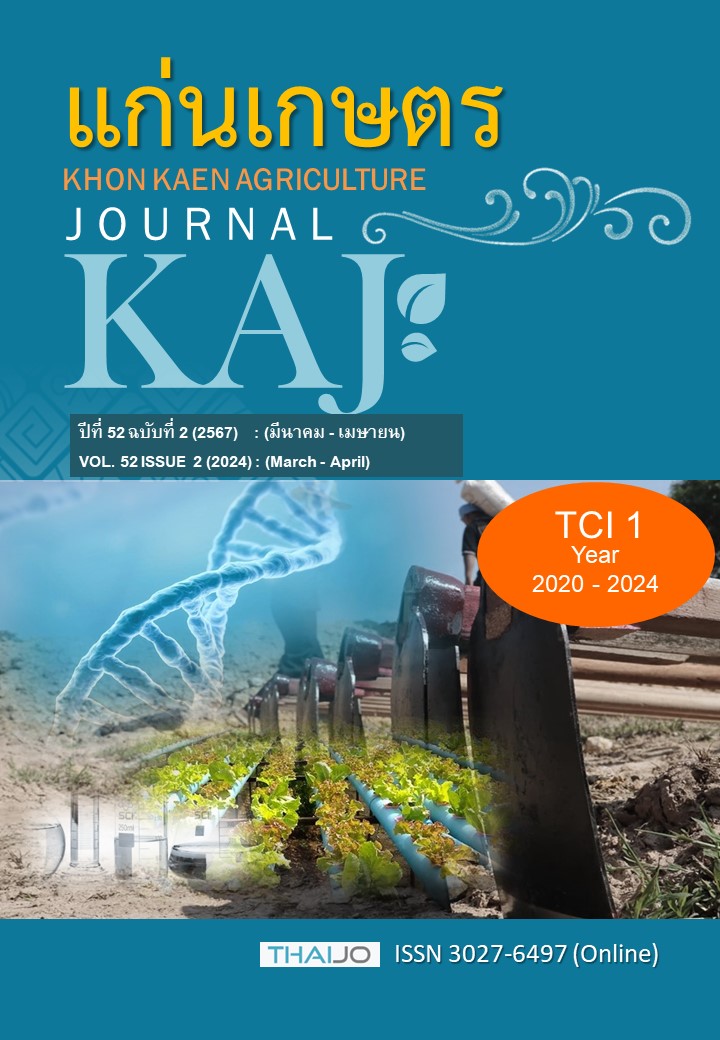การคัดเลือกและปรับปรุงประชากรแบบ S1RS โดยไม่ทดสอบรุ่นลูกในข้าวโพดพื้นเมืองกะเหรี่ยงอุทัย
Main Article Content
บทคัดย่อ
การศึกษานี้มีวัตถุประสงค์เพื่อปรับปรุงประชากรข้าวโพดพื้นเมืองให้มีความสม่ำเสมอ ฝักดก ผลผลิตสูง คุณภาพดี คัดเลือกและปรับปรุงประชากรปี 2561-2565 ด้วยวิธี S1 non-progeny recurrent selection 3 รอบการคัดเลือก แต่ละรอบการคัดเลือกประกอบด้วย 3 ขั้นตอน คือ 1) ผสมตัวเองภายในประชากร 2) ผสมแบบ bulk-full sib ในประชากร 3) ผสมแบบสุ่มในประชากร ได้จำนวน 4 ประชากร เพื่อประเมินความก้าวหน้าทางการคัดเลือก วางแผนการทดลองแบบ randomized completely block design (RCBD) มี 3 ซ้ำ โดยเปรียบเทียบประชากรพื้นฐาน (C0) ประชากรที่ผ่านการคัดเลือก C1, C2 และ C3 ร่วมกับพันธุ์การค้า ได้แก่ เทียนน้ำผึ้ง เทียนขาว เทียนลาย-52 และเทียนเหลืองขอนแก่น ระยะปลูก 0.75 x 0.25 เมตร แปลงย่อยละ 6 แถว แถวยาว 5 เมตร มีจำนวน 120 ต้น/แปลงย่อย ณ ศูนย์วิจัยและพัฒนาการเกษตรอุทัยธานี ในฤดูฝน ปี 2565 พบว่า ประชากร C3 ลักษณะผลผลิตก่อนปอกเปลือกและหลังปอกเปลือกตอบสนองต่อการคัดเลือก โดยมีค่าเพิ่มขึ้นจาก C0 เท่ากับ 691 และ 397 กก./ไร่ ตามลำดับ คิดเป็น 74.9% และ 55.4% ตามลำดับ ประชากร C3 มีจำนวนฝักทั้งหมด จำนวนฝักที่ 1 และจำนวนฝักที่ 2 เพิ่มขึ้นจาก C0 เท่ากับ 5,417 4,233 และ 1,185 ฝัก/ไร่ ตามลำดับ คิดเป็น 59.6% 113.6% และ 22.1% ตามลำดับ และยังพบว่าประชากร C3 มีจำนวนฝักทั้งหมดสูงกว่าพันธุ์การค้าทุกพันธุ์ คือเทียนน้ำผึ้ง เทียนขาว เทียนลาย-52 และเทียนเหลืองขอนแก่น จำนวน 338 112 3,386 และ 451 ฝัก/ไร่ ตามลำดับ นอกจากนี้จำนวนฝักทั้ง 3 ลักษณะ มีค่าสัมประสิทธิ์การตัดสินใจ 0.99 0.98 และ 0.77 ตามลำดับ ดังนั้น ประชากร C3 สามารถเผยแพร่เป็นข้าวโพดเทียนพันธุ์ใหม่ ที่ชื่อว่า กะเหรี่ยงอุทัย เป็นพันธุ์ผสมเปิด มีเมล็ดสีขาวอมเหลือง และสามารถใช้เป็นแหล่งพันธุกรรมในการสกัดสายพันธุ์แท้ และสร้างพันธุ์ลูกผสมข้าวโพดเทียนต่อไปได้
Article Details

อนุญาตภายใต้เงื่อนไข Creative Commons Attribution-NonCommercial-NoDerivatives 4.0 International License.
เอกสารอ้างอิง
กรมวิชาการเกษตร. 2562. การป้องกันกำจัดหนอนกระทู้ข้าวโพดลายจุด. แผ่นพับวิชาการ กรมวิชาการเกษตร กระทรวงเกษตรและสหกรณ์.
ธำรงศิลป์ โพธิสูง, อำไพ เรืองฤทธิ์ และสำราญ ศรีชมพร. 2556. การทดสอบพันธุ์ข้าวโพดข้าวเหนียว ลูกผสม. น. 49- 56. ในการประชุมวิชาการข้าวโพดและข้าวฟ่างแห่งชาติ ครั้งที่ 36 วันที่ 5-7 มิถุนายน 2556 หนองคาย: กรมส่งเสริมการเกษตร กระทรวง เกษตรและสหกรณ์.
ทัศนีย์ จำรัสกุล, กมล เลิศรัตน์ และพลัง สุริหาร. 2552. การตอบสนองต่อการคัดเลือกพันธุ์แบบหมู่ประยุกต์เพื่อเพิ่มจำนวนฝักคู่ในประชากรข้าวโพดหวานพิเศษ. แก่นเกษตร. 37(ฉบับพิเศษ): 27-32.
ภราดร อุปพงษ์, กมล เลิศรัตน์ และพลัง สุริหาร. 2560. การคัดเลือกพันธุ์แบบหมู่ประยุกต์จำนวน 4 รอบ เพื่อเพิ่มลักษณะฝักดกในประชากรข้าวโพดเทียนสีม่วง. แก่นเกษตร. 45(1): 143-152.
อุดม วงศ์ชนะภัย, เพ็ญลักษณ์ ชูดี, และสุภาพร สุขโต. 2564. ความสำคัญของข้าวโพดฝักสดในภาคกลางและภาคตะวันตก. น. 1-17. ในการจัดการความรู้ เทคโนโลยีการผลิตข้าวโพดฝักสดที่เหมาะสมในเขตพื้นที่ภาคกลางและภาคตะวันตก. สำนักวิจัยและพัฒนาการเกษตรเขตที่ 5 กรมวิชาการเกษตร.
Ajala, S.O., J.G. Kling, S.K. Kim, and A.O. Obajimi. 2003. Improvement of maize population for resistance to downy mildew. Plant Breeding. 122: 328-333.
Bedada, L.T. and H. Jifar. 2010. Maize (Zea mays L.) genetic advances through S1 recurrent selection in Ethiopia. Journal of Environmental Issues and Agriculture in Developing Countries. 2(1): 154-169.
de Galarreta, J. I. R., and A. Álvarez. 2007. Six cycles of S1 recurrent selection in two Spanish maize synthetics. Spanish Journal of Agricultural Research. 5(2): 193-198.
Dhliwayo, T., N. Palacios-Rojas, J. Crossa, and K.V. Pixley. 2014. Effects of S1 recurrent selection for provitamin a carotenoid content for three open-pollinated maize cultivars. Crop Science. 54: 2449-2460.
Gomez, K.A., A.A. Gomez. 1984. Statistical Procedure for Agricultural Research. John Wiley and Sons: Singapore.
Hallauer, A. R. 1974. Heritability of prolificacy in maize. Crop Science. 24: 755-759.
Horne, D.W., M.S. Eller, and J.B. Holland. 2016. Responses to recurrent index selection for reduced Fusarium ear rot and lodging and for increased yield in maize. Crop Sciences. 56: 85-94.
Hussanun, S., B. Suriharn, and K. Lertrat. 2014. Yield and early maturity response to four cycles of modified mass selection in purple waxy corn. Turk Journal Field Crops. 19: 84–89.
Jenweerawat, S., C. Aekatasanawan, P. Laosuwan, and A. R. Hallauer. 2010. Potential lines and hybrids developed from modified reciprocal recurrent selection in maize. Kasetsart Journal Natural Science. 44: 517–522.
Kesornkeaw, P., K. Lertrat, and B. Suriharn. 2009. Response to four cycles of mass selection for prolificacy at low and high population densities in small ear waxy corn. Asian Journal of Plant Sciences. 8: 425-432.
Khamkoh W., D. Ketthaisong, K. Lomthaisong, K. Lertrat, and B. Suriharn. 2019. Recurrent selection method for improvement of lutein and zeaxanthin in orange waxy corn populations. Australian Journal Crop Sciences. 13: 566–573.
Kist, V., V. S. Albino, M. Maraschin, and J. B. Ogliari. 2015. Genetic variability for carotenoid content of grains in a composite maize population. Scientia Agricola. 71(6): 480-487.
Koirala, K.B., D.B. Gurung, B. Bhandari, and J.B. Chhetri. 2014. Population improvement of yellow and white maize through reciprocal recurrent selection. Nepal Agricultural Research Council. 2: 130-132.
Kolawole, A.O., A. Menkir, M. Gedil, E. Blay, K. Ofori, and J.G. Kling. 2017. Genetic divergence in two tropical maize composites after four cycles of reciprocal recurrent selection. Plant Breeding. 136: 41-49.
Kolawole. A.O., A. Menkir, E. Blay, K. Ofori, and J.G. Kling. 2019. Changes in heterosis of maize (Zea mays L.) varietal cross hybrids after four cycles of reciprocal recurrent selection. Cereal Research Communications. 47(1): 145-156.
Maita, R., and J.G. Coors. 1996. Twenty cycles of biparental mass selection for pollinated in the open-pollinated maize population golden glow. Crop Science. 36: 1527–1532.
Peng, Z.B, M.S. Li, and X.Z Liu and J.Q. Li. 2007. Comparisons of three recurrent selection methods in the improvement of maize populations. Agricultural Sciences in China. 6(6): 657-664.
Ruiz de Galarreta, J.I., and A. Alvarez. 2007. Six cycles of S1 recurrent selection in two Spanish maize synthetics. Spanish Journal of Agricultural Research. 5(2): 193-198.
Sajjad, M., N.U. Khan, S. Gul, S.U. Khan, I.H. Khalil, S.A. Khan, S. Ali, N. Ali, I. Tahir, Z. Bibi, S.M. Khan, and I. Hussain. 2020. Maize cyclical populations (PSEV3-C0, C1 and C2) response over diverse environments. International Journal of Agriculture and Biology. 24(6): 1656-1664.
Sukto, S., K. Lomthaisong, J. Sanitchon, S. Chankaew, M.P. Scott, T. Lubberstedt, K. Lertrat, and B. Suriharn. 2020. Variability in prolificacy, total carotenoids, lutein, and zeaxanthin of yellow small-ear waxy corn germplasm. International Journal of Agronomy. 2020: 8818768.
Sukto S., K. Lomthaisong, J. Sanitchon, S. Chankaew, S. Falab, T. Lübberstedt, K. Lertrat, and K. Suriharn. 2021. Breeding for prolificacy, total carotenoids and resistance to downy mildew in small-ear waxy corn by modified mass selection. Agronomy. 11: 1793.
Xiaoyang, W., C. Dan, L. Yuqing, L. Weihua, Y. Xinming, L. Xiuquan, D. Juan, and L. Lihui. 2017. Molecular characteristics of two new waxy mutations in China waxy maize. Molecular Breeding. 37: 27.
Zhou, Z., L. Song, X. Zhang, X. Li, N. Yan, R. Xia, H. Zhu, J. Weng, Z. Hao, D. Zhang, H. Yong, M. Li, and S. Zhang. 2016. Introgression of opaque2 into waxy maize causes extensive biochemical and proteomic changes in endosperm. Public Library of Science. 8: 1-16.


